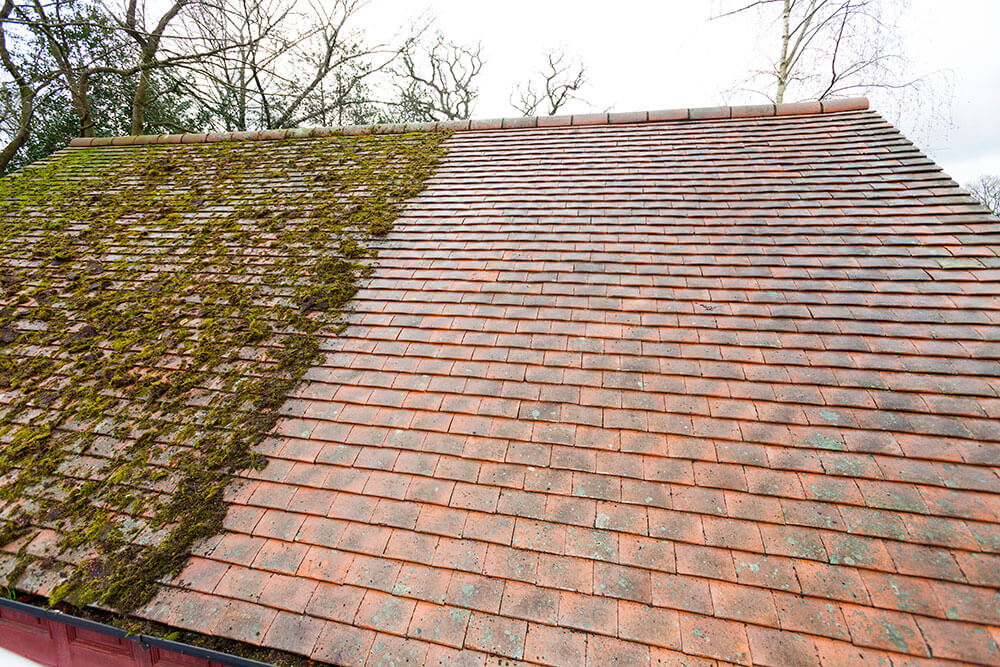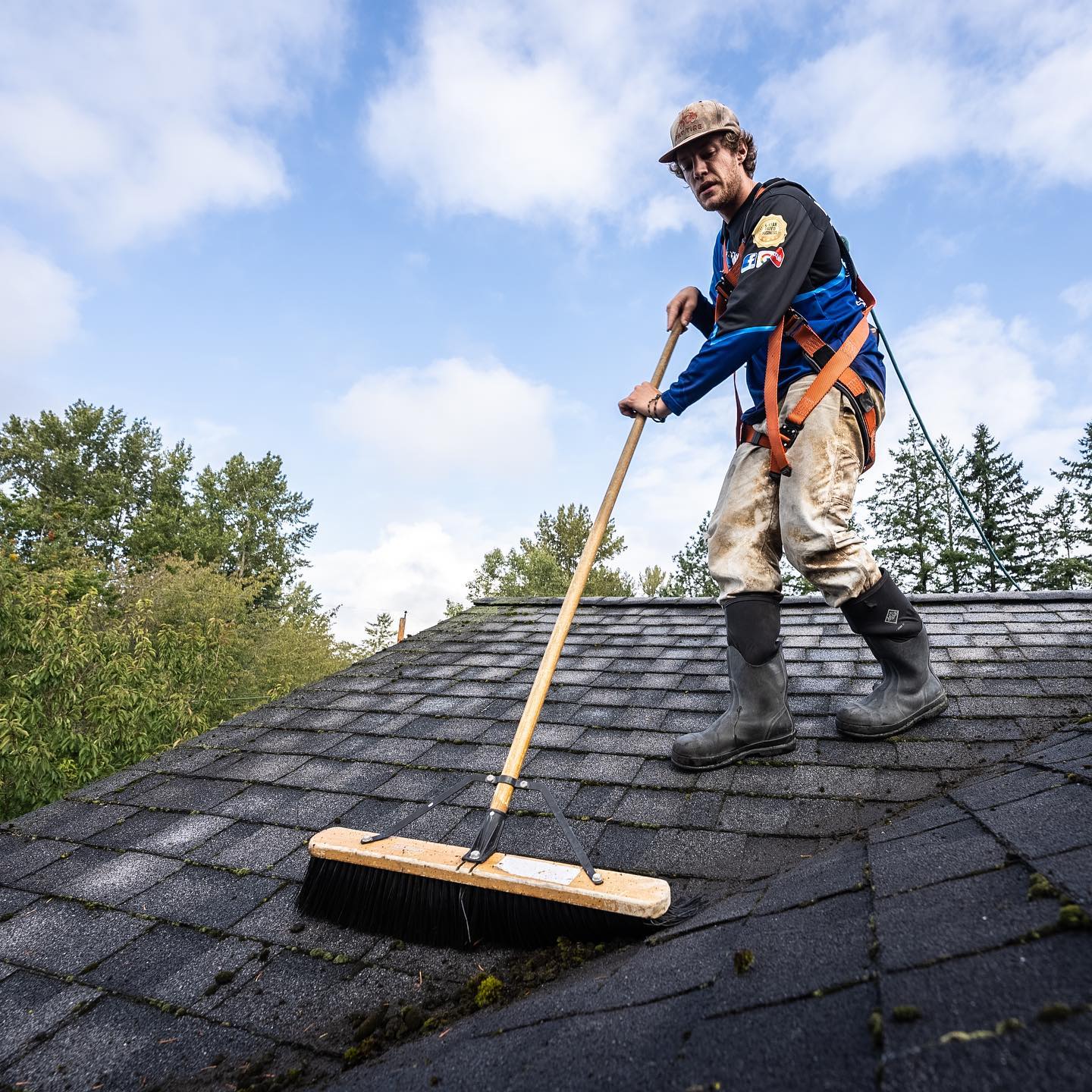A Comprehensive Overview to Roof Moss Removal for Every House Owner
Moss can grow in wet problems, leading to possible issues for your home. In this overview, you'll discover reliable techniques for removal and uncover exactly how to stop moss from returning.
Recognizing Moss: What It Is and Why It Expands on Roofs
While you could not assume much about it, moss is an usual concern on roofings, specifically in damp or shaded areas. Moss holds dampness versus your roof products, which can cause rot and degeneration over time.
If your roof covering has a great deal of organic debris like leaves, it creates an ideal breeding ground for moss. Comprehending exactly how moss spreads out and grows is crucial for efficient prevention and removal.

Identifying Moss Versus Various Other Roofing Growths
When it comes to your roofing, differentiating moss from other growths is vital for reliable maintenance. You'll commonly experience algae, lichen, and other sorts of vegetation, each needing various therapies. Recognizing how to recognize moss can save you time and help secure your roof covering's stability.
Common Roofing System Development Kinds
Recognizing the various sorts of development on your roofing is vital for reliable maintenance, as various organisms can significantly influence your roofing's health and wellness. You'll primarily encounter algae, moss, and lichen. Moss appears as soft, environment-friendly clumps and thrives in wet locations. Algae, on the other hand, frequently resembles dark streaks or discolorations, particularly on the bright side of your roof. It can spread out swiftly, especially in humid problems. Lichen incorporates algae and fungis, presenting as crusty spots that can be grey, green, or yellow. While all these growths can harm your roofing system, identifying them helps you determine the right elimination strategies. Stay watchful, and examine your roofing system on a regular basis to avoid major issues down the line.

Moss Recognition Tips
To properly identify moss from other roof covering developments, look closely at its appearance and shade. Moss usually looks like a soft, environment-friendly cover, resembling a carpet, and usually really feels spongy to the touch. It grows in wet, shaded locations, while other growths like lichen can be crusty and may reveal a variety of colors, consisting of grey or yellow. Algae, on the other hand, normally offers as dark streaks or spots and can appear slimed when wet. Take note of the development pattern; moss often tends to spread out uniformly, while lichen and algae might create uneven shapes. By observing these qualities, you can properly determine moss and take the necessary steps for removal.
The Dangers of Ignoring Moss on Your Roof
Neglecting moss on your roof can lead to considerable architectural damages and pricey repairs. When moss prospers, it catches dampness versus your tiles, increasing decay and advertising leaks.
Furthermore, moss can lift shingles, making them a lot more prone to wind damages (Roof Moss Removal Nanaimo). You might think it's simply a cosmetic trouble, but those relatively harmless environment-friendly spots can bring about major structural honesty problems. If your roofing deteriorates, you'll encounter not just repair prices however also possible safety threats for your family members.
Disregarding moss isn't just an upkeep oversight; it can develop into a looming hazard to your home's worth and your tranquility of mind. Stay cautious and address moss without delay to safeguard your financial investment and stay clear of future headaches.
Reliable Moss Removal Methods
Dealing with moss on your roof is the initial step in shielding your home from damages. This method helps reduce damages while removing click this link the moss.
Following, consider applying a moss removal option. You can use a store-bought product or produce a Do it yourself blend of water and vinegar.
For persistent patches, a stress washing machine can be efficient, but utilize it thoroughly to avoid tile damage. Keep your roofing clean by trimming looming branches and guaranteeing correct drainage. Regular upkeep can stop moss from returning and maintain your roof in leading form.
DIY Moss Removal vs. Working With a Specialist
While you may feel positive taking on moss removal on your own, weighing the benefits of DIY techniques against working with a specialist can help you make the ideal option for your roofing system. Do it yourself moss removal can save you money and provide you a sense of achievement.
On the various other hand, employing a specialist can supply satisfaction. Specialists have the tools and experience to eliminate moss effectively and securely, minimizing the danger of damage to your roof. They can likewise identify any kind of underlying problems that may require interest. Ultimately, consider your budget plan, comfort degree with heights, and the moment you can dedicate to the task when selecting in between DIY and professional solutions.
Preventative Actions to Maintain Your Roof Covering Moss-Free

Consider mounting zinc or copper strips along the roof covering ridge. Rainfall will certainly wash off steel particles that prevent moss development. Furthermore, utilize a biocide treatment especially designed for roof coverings to hinder moss and algae before they begin.
Finally, check your roof regularly for indicators of moss or algae and address any kind of issues promptly. By taking these positive steps, you'll not just maintain your roof covering looking great but also prolong its lifespan and prevent pricey fixings in the future.
Upkeep Tips for Long-Lasting Roof Wellness
Preserving your roofing's health and wellness is vital to ensure its long life and prevent expensive fixings down the line. Start by regularly evaluating your roof for damage, this such as missing shingles or leakages. Make it a routine to cleanse your gutters a minimum of twice a year, making sure water drains pipes correctly and does not merge on your roof. Cut overhanging branches to reduce debris buildup and decrease the threat of moss development.
If you see significant moss or algae, address it without delay to avoid damage. By adhering to these straightforward maintenance ideas, you can maintain your roof covering in top shape and prolong its life expectancy substantially.
Often Asked Inquiries
Exactly how Frequently Should I Inspect My Roof Covering for Moss Growth?
You should inspect your roof for moss development a minimum of twice a year, ideally in spring and autumn. Roof Moss Removal Nanaimo. Routine inspections help catch any kind of issues early, avoiding possible damage and ensuring your roofing system remains in great problem
Can Moss Damages My Roofing Tiles?
Yes, moss can harm your roofing shingles. It traps wetness, leading to rot and deterioration. Act quickly to eliminate it and avoid further damage to your roof's stability and life-span. if you discover moss.
What Weather Conditions Promote Moss Development on Roof Coverings?
Moss grows in wet, shaded settings with high humidity. If your roofing system obtains little sunshine and experiences frequent rain or haze, you're likely to see moss growth, which can damage your tiles over time.
Is It Safe to Stroll on My Roofing While Eliminating Moss?
Strolling on your roof while getting rid of moss can be risky. You must examine for security and prevent slippery surface areas. Always put on suitable footwear and consider using security gear to stop crashes during the process.
What Are the Long-Term Results of Roof Covering Moss on Home Worth?
Roofing system moss can reduce your home's worth by developing an unclean appearance and possibly creating architectural damage. If left untreated, it might bring about costly fixings and prevent potential purchasers from considering your home.
Disregarding moss on your roof can lead to significant architectural damages and costly repair work.Addressing moss on your roof is the initial action in safeguarding your home from damage. Specialists have the devices and experience to eliminate moss successfully and securely, decreasing the risk of damage to your roof covering.Yes, moss can damage your roof tiles. If you discover moss, act quickly to eliminate it try these out and avoid additional damages to your roof's integrity and life-span.